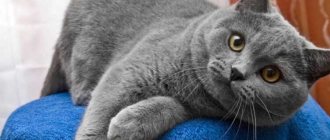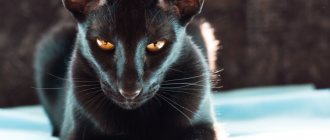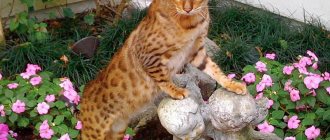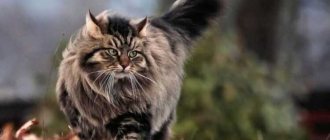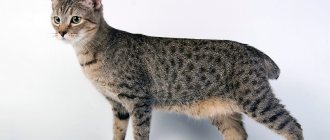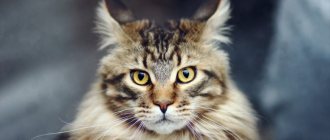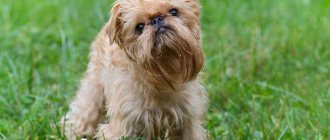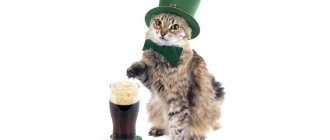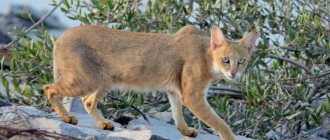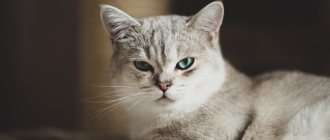The miniature leopard is one of the youngest breeds. The popularity of such felines is explained by the fact that their appearance is similar to a wild animal, and their habits correspond to those of a domestic pet.
In the photo of the Bengal cat you can see this similarity. The mini-leopard has a lot in common with its ancestors. They are full of energy and therefore very active.
Unlike many breeds, they eat several times a day. At the same time, they practically do not gain weight, as they are constantly on the move.
History of the origin of the Bengal cat breed
The Bengal cat is a hybrid of a domestic and wild cat (wild Asian leopard cat), which was bred through selective breeding. The history of the breed began with Jane Mill, an American biologist who bred the Bengal cat. Even during her studies, the woman learned about the results of crossing distant breeds. This only caused laughter from her superiors, because all that was required from cats and selection was a good hunting instinct.
Jane once saw the wild ancestors of Bengals during a business trip to Taiwan. Then they were especially popular in the Far East. Poachers shot wild predators to get beautiful fur. The remaining cubs were sold right on the streets as souvenirs.
Such unreasonable behavior led to the extinction of the wild species by the 20th century. Jane Mill managed to take one kitten with her to America, Arizona. It was a cat that gave birth to an ordinary domestic cat. This is how the first Bengal kittens were born, with good characteristics, but they still had a path of selection and development ahead of them.
Jane began breeding them 15 years later in 1970. She wanted to breed a domesticated hybrid, something between a wild and a domestic animal. Jane selected kittens with the most obvious and beautiful features of their wild ancestors. We selected affectionate and obedient cats who had a positive attitude towards people. Thanks to this, the Bengal cat has positive characteristics.
The Bengal cat received official recognition in 1983, when the breed was registered by felinological organizations. In 1987, the new breed took part in an official exhibition for the first time. In 1997, the Bengali beauty was already presented at exhibitions in Moscow. Today, buyers can purchase the best Bengal cats, but the breed is still a work in progress.
Rare spotted cats
Since the leopard pattern is popular among cat lovers, breeders are constantly experimenting with creating new varieties of tabbi-spotted pets.
Australian smoke
Australian smoke
Fluffy pets from the Australian continent count among their ancestors a whole “bouquet” of representatives of various breeds, including Abyssinians, Burmese and Siamese, as well as ordinary yard cats. From their aristocratic ancestors, Australians inherited elegance and grace, and from mongrel purrs - good health. The tabbie color is quite common in these cats. The character of Australians is flexible, their temperament is energetic and restless. Outside Australia, representatives of the breed are not often found.
California radiant
The goal of California Shining's creators was to create a domestic cat that resembled a leopard to remind people of the importance of preserving wildlife. The starting material was a variety of breeds: Siamese, Angora, Abyssinian, Manx, British Shorthair.
California radiant
Californians have a lean body structure, developed muscles, and a high level of intelligence. Animals are open to communication, inquisitive, love to frolic and jump. They take part in group games with pleasure. The spotted skin can have one of the following shades: black, blue, silver, gold, bronze, brown, red, smoky charcoal.
Ussuri
The young breed, descended from Amur forest cats and Siberians, is not yet very widespread. The surface of the spotted coat is colored in golden-fawn tones, the belly is slightly lighter. Its character resembles that of a predatory animal, cautious and distrustful. Extraordinary hunting abilities.
Kenyan (soukok)
Kenyan forest cat (soukok, sokoke)
Cats from the very heart of Africa differ in gene composition from ordinary domestic purrs. The ancestors of these flexible, muscular, marbled beauties are considered to be feral pets that formed pairs with four-legged small predators from the African forests. Despite their wild origins, Kenyans are distinguished by their flexible and calm disposition. Curious, active, friendly.
Appearance of a Bengal cat
Bengal is a mini leopard that happily lives in people's homes. The Bengal cat is considered elite, the description of the breed confirms this fact. She has a special breed standard, which includes external characteristics.
Height and weight
Bengals are classified as medium and medium-large animals. Maximum weight 7-9 kg. Males weigh more than females. This characteristic makes it possible to use males at exhibitions with great success. They have a more pronounced muscular corset, developed limbs, etc.
Height is 25-33 cm. The most active phases of growth occur at the age of 9 months. Then the pet gradually gains weight up to 2 years. Afterwards the animal no longer gains weight.
Length and shape of limbs
The paws are powerful, strong and muscular. They are very strong. The bones are wide. The length of the front legs is slightly less than the hind legs. The pads are large. The toes are well developed and separated. The tail is long and decorated with black rings. Tapers slightly towards the end.
Head
The wild Bengal cat has a wedge-shaped, elongated head shape, which is typical for wild cats. The back of the head is located in line with the neck and is its continuation. The head is large when compared with the size of the body.
The jaws are well developed. The cheekbones stand out and are set high. The nose is large and wide. The mustache area is convex.
The ears are medium in size and proportional to the head. The base is wide, open, the end has a rounded tip.
Eye color and shape
The Bengal cat has medium-sized eyes. They are highlighted with a dark rim. The shape of the eyelids is round. The iris color varies from emerald green to amber. Certain colors have blue and blue eyes.
Wool
The fur is thick and silky to the touch. It looks neat, as if it shines from the inside. The fur fits tightly to the skin. A description of the colors will help you choose a beautiful animal that will please the eye.
Cats look beautiful in photos and videos. After purchasing a Bengal, a lot of comments and reviews under Instagram posts are guaranteed.
To select the best cat, you should pay attention to its fur in childhood. It should be bright, dense, shiny.
Interesting!
Pets' fur does not smell of anything, because... they are pretty clean.
Constitution
The body is long and graceful with a pronounced muscular corset. This is the type of cat that does not suit obesity. The body, although elongated, is proportional to the limbs. The bone structure is strong.
Voice
The animal is talkative. The voice is loud and ringing. The animal is constantly talking. Some owners get scared when they hear such talk for the first time, mistakenly believing that the pet is unwell.
Important!
The Bengal cat breed is very noisy and talkative. Despite this, most owners remain satisfied with their choice.
Lifespan
Bengals are long-lived, it is already known how many years they live. On average, pets live 15 years. Often healthy and large individuals live for 20 years. It is worth taking this into account when taking on such responsibility. After all, Bengals are loud, active and need constant attention.
Life expectancy largely depends on the initial characteristics of the animal. If your pet has a strong immune system and a positive attitude, he will easily become a long-liver.
Possible defects
Some cats are not allowed to be bred, and the possibility of their participation in exhibitions is excluded. Pets with these traits are much cheaper.
Common disqualifying faults:
- strabismus;
- color that does not match the breed (for example, brindle spots on the fur);
- inclusions of hairs of a foreign shade in the basic colors of the coat (light hairs on the brown color);
- the presence of extra toes on the paws or their absence;
- amputated claws (some owners perform a special operation, which is not humane).
The best Bengals are show class. They have no flaws and cost from 80-100 thousand rubles. They are purchased for breeding and exhibitions.
Description of the pet
This breed amazes with its non-standard colors and sizes. Cats have slightly elongated legs and a slightly lean body. On average, representatives of this breed are 30 cm tall and weigh about 5 kg.
Weight parameters depend on nutritional balance. The hind legs are longer than the front legs, so the cat can jump quite high. The tail of the Bengal cat is unusual; it is oblong with a thickening.
A miniature leopard has a small head in relation to its body. However, this disproportion does not affect the external beauty of the breed.The eye color is the same as that of the Asian leopard. The skull is wedge-shaped with small rounded ears. The whisker line and wide bony nose give the pet elegance.
Mini leopard - short-haired with spots. Their fur is shiny and shimmery.
The colors of Bengal cats are very diverse, however, all breeds have characteristic spots, and the tip of the tail must be a darkish shade.
Coat color
Thanks to its wild color, the Bengal cat has gained worldwide fame. A large list of colors is officially recognized, which is presented in the photo. The main requirement for fur is maximum contrast between the background and the pattern. The paws and tail are always distinguished by a pattern in the form of stripes rather than spots.
Interesting!
Kittens may be born light colored. As you get older, a pattern will emerge. The kitten's final Bengal color appears at 8 months.
By pattern type
The color of Bengal cats is not only multi-colored, but also has different patterns. There are several dominant colors: leopard, spotted and marbled.
Leopard (Rose)
These are the most common colors. Already from the name it is clear that this is a pattern consisting of beautiful spots of “rosettes”. The outline of the rosette is highlighted in black or dark brown. The core is darker than the main fur, but lighter than the outline. The socket can have a closed or open circuit.
Spotted (Spot)
The description of the spotted pattern is quite simple - these are monochromatic spots of dark color located throughout the fur. They should be very bright and contrasting. Usually their size is slightly smaller than that of a socket. There are different types of stains. Most likely they will be round, but there are also oval, elongated spots.
Marble (Marble)
The marble color is much less common than leopard and spotted patterns. The stripes are located along the fur coat, and not across, like the usual stripes of the British. The Bengal marbled cat has spots of various shapes. The main condition is their clear outline. The marbled cat looks more like a tiger cub than a leopard.
By coat shade
The color of Bengal cats is divided into 5 main shades of fur. The golden shade is considered classic. In addition to it, there are silver, snow, blue and charcoal colors.
Golden (Brown)
The main color of the coat varies from golden yellow to light brown. The spots are highlighted in dark brown or black. The eye color is green or golden. The tip of the tail is always marked black.
Silver
The background fur is white, gray or silver, steel. The tip of the tail is also marked with a black spot. The markings on the fur are gray with a black outline. The eye color is green or golden.
Snow
Snow color is further divided into snow lynx, mink, sepia - from lightest to darker. In general, the snow cat has a light fur color - cream or ivory. Sometimes the fur is almost white. The marks can be light, as if faded, or more pronounced - beige, dark brown. Eyes can be blue, green, green-blue, golden.
Snowy colors are valued by breeders. Less often it can be found in combination with a marble pattern.
Blue
The fur is gray with a blue tint. These types of colors are not found very often. The main thing in describing this color is the cold undertone of the coat. The spots are gray-blue or dark gray. The iris color is green, brown or golden. The end of the tail is highlighted in dark grey.
Coal
The main color of the fur is charcoal, dark gray or brown. The Bengal cat in the photo is a perfect example. This photo shows fur with a cool undertone. The spots are highlighted in an even darker shade. Outwardly, it looks like the cat really got dirty in something charcoal-dark. The muzzle has a patterned mask with white circles around the eyes. Eye color is green, golden or brown.
Classification Features
The classic color of the Bengal breed is a golden tone of the undercoat with bright rounded spots of various black-brown shades in their most varied variations, from milk chocolate to black. The belly, bleached almost to a platinum hue, is welcome, and this is also a reference to the original origin of Bengals from wild ancestors.
All Bengals are genetically black or blue in color (the bleached black gene in cats), but the shape of the pattern on their coat is extremely varied and varies from spots that look like “polka dots” to fancy round “lambs” and vague “islands” throughout the body of the cat. The pattern can be spotted or marbled; it is important that all elongated fragments are oriented horizontally; tendencies towards the formation of vertical stripes are unacceptable. The spots can have any size and shape, including something as exotic as, for example, “oyster shell” or “butterfly wings.” Complex stains are preferable to simple single ones. It is necessary that each drawing clearly contrasts with the background, is impeccably clear, with clearly, even sharply expressed outlines. There is no special standard for the pattern of spots, there is only a single requirement: the main background of the coat must be extremely clean and uniform, and the pattern must be equally extremely clear. The introduction of such a standard would be pointless, since absolutely every Bengal has its own “own” unique color. Repeating patterns do not exist in nature, clearly demonstrating the boundlessness of her imagination. It is not without reason that all these spots, rosettes, etc. are often compared to human fingerprints - they are just as unique.
A distinctive feature of the Bengal breed is considered not only its amazing color, but also the quality of the fur of these animals. In the short-haired variation of the breed, it is thick and dense; unusually soft and silky to the touch, it creates an indescribable sensation when you touch it. (2)
Types of colors:
- spotted Can be expressed in the form of single spots (single spotted) and rosettes (rosetted);
- marble;
- sparble (sparble from the English marble + spotted, that is, spotted + marble).
Characteristics and habits
Thanks to active efforts and strict selection, the Bengal cat has a good character. Breeders managed to breed active, affectionate and intelligent cats. The work is still ongoing, but the breed has already developed its own behavioral characteristics.
It is not so important how much a cat costs and what kind of jewel it represents in the animal world. It is much more important whether her character is compatible with the character of her owners.
Attitude towards people, children, animals
Despite its wild nature, the Bengal cat breed loves company. They cannot be alone for a long time. Cats have a hard time making contact with strangers. They get used to the owner who supports them and trust only him.
They treat children with patience; they try to avoid babies. If a child strongly pulls the Bengal's tail, whiskers, or ears, he may respond. It is better to explain to children in advance how to behave with a pet. They love to play with children aged 9-13 years, which thoroughly exhausts each other, and then they sleep soundly. They live well in the family.
Important!
Bengals always choose one person (the main one) to spend more time with. The other owner is perceived as a victim and may bite and scratch him in a playful manner.
Cats do not get along with other pets because... begin to divide the territory. At best, each will choose their own corner without disturbing the other.
Education, obedience, training
The wild Bengal cat carries 25-70% of the blood of a wild animal. It is impossible to make an obedient domestic kitty out of her. An animal can live with a person only on its own terms. Despite the fact that upbringing and Bengals are not very compatible, they themselves are quite aristocratic and well-mannered.
Breeders accustom kittens to being handled from the first day of birth. Otherwise, the person will become an enemy for the Bengal cat. At all stages of growing up, the owner actively interacts with the animal with his hands.
The Bengal cat receives positive reviews when it comes to training. Cats are successfully taught basic commands and even complex tricks. By watching people, they independently learn to open taps, doors, cabinets, and press switches.
Playfulness, curiosity, activity
Bengals love to run, jump, skip and climb. It is better to install a full-fledged play complex for them, where they can play, relax, and hide.
They constantly carry their toys in their teeth and even bring a ball to their owner. In this they are similar to dogs. Plays with ribbons and feathers with great interest. Needs a lot of toys. They love to take part in new games.
The Bengal cat breed is not afraid of water, because... their wild ancestor regularly walked in the rain and crossed rivers. They can easily jump into the bath and play with the tap water.
Important!
Not everyone understands why a Bengal needs a playroom. If your Bengal does not play regularly, he will begin to toil and release excess energy in destructive ways.
Intelligence
The main features of Bengal cats are their developed intelligence, willfulness and quick wit. If a Bengal sees a person opening the door where he hides his treats and toys, he will independently get what he needs. Then you shouldn’t be surprised why the cat treacherously takes out all the owner’s supplies.
Animals are always coming up with something. They can play with ordinary household things and have fun. They easily find new loopholes, minks, and conquer heights. They engage themselves independently.
Many reviews tell funny stories about how the animal independently opened the closet and carefully pulled out things from there. The intelligence in the eyes of an animal is easy to see even on video.
Sensitivity
The Bengal domestic cat has a reverent character. They cannot tolerate shouting or inappropriate treatment. Avoids conflicts in every possible way. If a pet is offended, it will leave and hide. He will wait until the owner and himself calm down.
They feel guilty. If the pet has done something wrong, it will suck up to its owner and meow pitifully.
Instincts
The cat has a good hunting instinct. She is freedom-loving, will not be able to tolerate long hugs, and will not sit in one place for hours.
Does not like enclosures or closed small rooms. She needs free space around. Otherwise, she will scratch the doors, become indignant, and become fearful and aggressive.
Important!
A Bengal cat cannot be forced to do anything. It is important to give her freedom and respect her personal space.
Description of Asian leopard cats
Asian leopards live in the forests and plains of Asia, and in Russia - in the Ussuri taiga. Wild Bengal cats are no different in size from ordinary cats, but they have longer limbs. Body length with tail is 80–100 cm, height at withers 40–41 cm, body weight from 4 to 7 kg. Cats are much larger than cats.
External data
Leopard cats are considered short-haired. Their main color ranges from pale yellow to golden yellow, reddish yellow or gray yellow. Dark spots are scattered across the main background, which can have different sizes and merge into stripes or rosettes on the neck and back of the animal. Often 4 black stripes run from the forehead along the head, which break off on the neck and back and turn into oblong spots. The lower part of the head and body (chin, chest, belly, inner surface of the legs) are always light, almost white, with a spotted pattern.
The body of these small predators is elegant but strong, with a small head and rounded ears.
The head is small in size, the muzzle is short and narrow, with rounded ears of medium height and width. On the dark outer side of the ears there is a white (wild) spot in the center. The eyes are large, the color is yellow, amber, brownish, less often light blue. From the outer corners of the eyes, two pairs of black stripes with a white area between them descend down the head. The nose is large, convex, pink or brick-colored, and the lips are dark.
Characteristic features of this type of wild cat are rounded ears and large round eyes with a dark rim around them.
The body is compact but muscular, with long legs (the hind legs are higher than the front ones) and noticeable webbing between the toes. The tail is approximately half the length of the predator's body, well-furred, covered with spots or stripes, with an obligatory black tip.
The tail of these predators is not very long and often has the shape of a carrot: wide at the base and tapering at the end.
Character
The Asian leopard cat is a solitary cat by nature and communicates with members of its species only during the breeding season and raising kittens. However, when kept in captivity, it gets along well with both its relatives and ordinary cats and dogs. In the wild, she is extremely unsociable, timid, and attacks only as a last resort. He prefers to hide from danger in a safe shelter and watch the events taking place from there. It is difficult to find such a cat in its natural habitat, since it is not only cautious, but also knows how to camouflage perfectly, which is facilitated by its specific color.
If there is a need to protect himself or kittens, then ALC will do this desperately and quite aggressively. Growling, hissing and snorting, as well as claws and teeth will be used. Even small kittens found in the forests and picked up by a person will bite and scratch vigorously until they run out of strength. That is why they need to be tamed from infancy.
ALC react to everything unusual and threatening, from their point of view, with a hiss and then a growl; these animals meow much less often
The wild Bengal cat is very independent, and even being tamed from childhood, does not welcome excessive caresses and stroking from humans, and also does not like to sit in hands. Due to its fearfulness, this animal has low resistance to stress and can easily get sick and die from a mentally traumatic environment - transportation, loud noise, contact with other animals, especially during adolescence (6-7 months from birth).
These predators, being caught at a conscious age for zoos, have a very difficult time enduring the situation of restriction of freedom
Asian leopards are absolutely safe for humans; they can only hiss threateningly if they violate a cat’s personal territory. And the weight category is not the right one to fight a person. Adult ALCs are not domesticated; training them to use a litter tray is almost impossible. They rarely breed in zoos, since the stressful situation of limited freedom negatively affects even the sexual instincts of these predators.
Lifestyle
Wild Bengal cats are predominantly nocturnal. They feel good in any forest: tropical, coniferous, deciduous, as well as in savannah, semi-desert and mountains. They spend the daytime in a den, which they make in hollows or roots of trees, caves, burrows abandoned by other animals, and at night they go out hunting. The best place for a female with kittens to hide is in dense undergrowth, into which large animals and humans cannot penetrate. Asian leopards try in every possible way to avoid humans and stay away from their settlements.
Asian leopard cats are very careful and try to hide in their shelters from all possible dangers, especially from humans.
Leopard cats prefer to settle near rivers and lakes, although they rarely get into water. They can swim and fish, but usually hunt on land. Water prey is turned to in case of severe hunger. The territory of one animal, both male and female, can occupy 2–3 square kilometers. Wild cats mark their areas with urine and excrement. Water serves these predators not only to quench hunger and thirst - they have an interesting habit of urinating, and sometimes defecating, in running water. Most likely, this is due to the desire to hide traces of their presence from potential enemies.
These predators are known as excellent steeplejacks; they move deftly over mountains, rocks, trees and love to attack prey from above
Wild Bengal cats are not only good swimmers, but also excellent climbers. They are excellent climbers and jumpers on mountains, rocks and trees, and love to rest in trees during the day. Hiding in the branches, they hunt birds, squirrels and tree shrews.
Nutrition
Asian leopard cats are exclusively carnivores. Their prey is very diverse: hares, rodents, birds, amphibians, reptiles and even insects. If possible, they will enjoy eating eggs, fish, and green grass, which improves digestion. But the basis of their diet is mice, hamsters and rats, so sometimes cats settle near human houses and effectively hunt mice living on farms. Unfortunately, in doing so, they often destroy chicken coops, which earns them hostility from farmers.
Wild leopard cats are fast and agile hunters. They hunt from ambush, jumping out with lightning speed and biting their prey. ALC does not play with its prey, but holds it with its claws until it dies. Capable of dragging prey in its teeth and hiding it in a secluded place.
Reproduction
In nature, Asian leopards become sexually mature at the age of one and a half years, in captivity much earlier. In the southern regions, leopard cats breed at any time of the year, and in the northern regions - in March-April, when natural conditions allow the cubs to be successfully cared for. If for some reason the kittens from the spring litter die, then the female can bring offspring again, closer to the beginning of autumn.
ALK kittens are born blind, their eyes open after about 10 days
The ALC's pregnancy lasts approximately 9–10 weeks, most often the litter consists of 2–3 kittens. Kittens are born blind, their eyes open only at 10–11 days. After the kittens appear, the male often lives with the female and helps raise the offspring. The cubs do not leave the den for about a month, feeding only on their mother's milk. Starting from the age of one month, they grow fangs that allow them to taste meat food, their weight rapidly increases and they begin to leave their shelter for a short time. Parents bring live prey to the den and teach the kittens to hunt. The female raises the cubs until about 10 months of age, after which they begin independent life.
Lifespan in the wild
The lifespan of Asian leopard cats in the wild is 12–15 years.
Care and maintenance
The cat took from its ancestors not only beauty, but also independence. Caring for its appearance is very simple.
Moving into a new home
Keeping this breed is a little more difficult than keeping a regular cat. Bengals need an organized territory, where there will be a food, recreation area and, of course, a large play area. Then he will not spoil the furniture and disturb the owners.
Basic set of items:
- A full bowl of clean drinking water and dry food should be freely available.
- Place a tray in a secluded place that matches the size of the cat. Representatives of the breed like to actively bury their surprises, so the layer of filler should be large.
- It is advisable to install a running wheel where cats will expend excess energy.
- A scratching post is a must. Sometimes one set of cat posts is not enough. The animal is allowed to sharpen its claws only in one place, away from upholstered furniture and walls.
- You can equip a sleeping and rest area. If she is not there, the pet will find a place for itself in a chair, on the sofa or in the bed.
Hygiene and medical procedures
Caring for Bengals is simple, although it should still be done regularly:
- It is enough to brush your cat once a week. The fur is short. She does not need daily brushing, because... tangles do not form, and shedding is not as obvious as in long-haired breeds.
- Discharge from the eyes is removed daily using a damp cotton pad. Some animals cope with them on their own.
- Ears are examined every 1-2 weeks. They should be clean and light pink in color. If there is dirt, clean the ears with a damp cotton pad.
- To prevent your pet from tearing up the beautiful interior and upholstered furniture, her claws are trimmed every 2 weeks. Use a special nail clipper. Even if you have a scratching post in your home, you still need to trim its claws.
- It is not necessary to wash the libimitsa; they are very clean. Bathing is carried out no more than once every 3-4 months, or it is carried out with very intense pollution. They use only specialized products for cats. Bengals love water, so washing them will not be a problem.
Diet
The most convenient and simplest feeding option is to purchase ready-made commercial feed. The menu will be balanced, healthy, and the owner will not have to cook.
They buy premium, super-premium, holistic food. Like its wild ancestors, the Bengal cat has a shortened intestinal structure. She has a sensitive digestive system that immediately reacts to low-quality food, chemical additives, and changes in diet. Finding the right food will take some time.
Some owners still prefer natural food:
- 80% of the total diet is meat. It must be dietary. Suitable for turkey, chicken, rabbit, beef. 1-2 times a week you can treat your cat to low-fat varieties of fish. The fillet should be boneless. The meat is deep frozen in advance for at least 3 days. Before serving, it is doused with boiling water. This way the owner gets rid of parasites and bacteria.
- They are not allowed to give milk, but it is useful to treat them with fermented milk products. Kefir and low-fat cottage cheese are an excellent addition to the basic diet.
- Vegetables. To ensure that the cat receives all the necessary vitamins, raw or boiled vegetables are added to the meat.
- Cereals must be included in the daily diet. They are boiled in water in advance.
Important!
Food from the human table negatively affects the health of the pet. You cannot treat them with sweets, highly salty foods, or fatty fried meat. Beans and potatoes are contraindicated.
Cat care
Caring for Bengal cats is not much different from regular animal care. It is necessary to carry out vaccinations on time, buy proper food, and bathe several times every 2 months.
You need to play with cats so that they expend their energy. If you raise a cat with love, he will grow up to be a real pet leopard.
Hereditary diseases
In addition to infections, any cat is susceptible to genetic diseases. This problem has not escaped the Bengals either. There are several types of most common diseases.
Gastrointestinal problems
This is a problem of the first order. Bengals have a sensitive stomach and a shortened intestinal structure, characteristic of wild cats. They are susceptible to food poisoning. It is difficult for animals to choose food; it is rarely possible to do it the first time. Any new treat causes digestive problems and changes in stool.
Here, owners will have to be patient and give preference to holistic or premium food. It is better to coordinate the new menu with the veterinarian, informing the doctor about the pet’s problems.
Progressive retinal atrophy
The disease is painless for the cat and unnoticed by the owner. Gradually the retina of the eye dies, leading to complete blindness. It's not always clear why this happens. Usually the disease is diagnosed at the age of 5-6 months. It can be stopped early to avoid big problems. Nothing can be done about the chronic form.
The first symptoms are night blindness, avoidance of dark rooms, slow movements, lack of reaction to a change of environment (crashes into a new table or jumps onto a cabinet that no longer exists).
Hypertrophic cardiomyopathy
Cardiovascular disease can be congenital or acquired. This is a tendency to heart disease, which is provoked by one of the thickened walls of the myocardium. In the early stages, the disease is not diagnosed during a standard examination; there are no symptoms. If left untreated, it can cause sudden death.
For this reason, it is important to conduct an annual cardiac ultrasound and ECG to ensure that your pet does not get worse. With medication support and a calm lifestyle, the cat will live a long life.
Important!
These diseases are rare. Despite this, it is important to monitor the animal’s condition in order to prevent the development of a chronic form of the disease.
Wild spotted cats as pets
The custom of keeping wild animals similar to leopards at home has been known since ancient times. In recent decades, this fashion has returned again. However, not all members of the cat family are harmless enough to live with people. Among wild spotted pets, there are only three species recognized as relatively safe.
Serval
A slender cat with elongated limbs, large ears, and a miniature skull resembles a cheetah in proportions and coloring. Servals are classified as medium-sized wild cats. The average weight of the animal is 20 kg, the total length (including tail) is 1.5 meters.
In order for a Serval kitten to grow up sociable and friendly to people, the baby must be separated from its mother in the first days of life. Such conditions can only be organized by professional breeders.
Serval
A properly trained cat will be a good companion for its owners, but it must be remembered that natural instincts can manifest themselves at any time. Therefore, an adult pet should be kept in a separate enclosure.
The Serval should be fed mostly raw meat. Until your pet matures, you need to include enough foods high in calcium in your diet, since young animals with weak limbs are at high risk of fractures.
Ocelot
Ocelot
The ocelot is a predatory animal that looks like a smaller copy of a leopard. Compared to the Serval, the character of the Ocelot is more obstinate, so the animal requires keeping exclusively in an enclosure. There are cases when these beautiful animals lived with artistically gifted individuals, for example, with the artist Dali.
Geoffroy's cat
Geoffroy
This wild representative of the cat family is the same size as a domestic cat. The animal’s soft, short fur with dark spots on a golden-yellow background has long attracted manufacturers of fur products, which almost caused the extinction of the species. These animals are rarely found as pets, since domestication of kittens must begin from the first days of life.
How to choose a kitten, its cost
There are kittens of the early generation (basic Bengals F1). One of their parents is a wild leopard cat. The kittens retain the wild habits and distinct external characteristics of a wild leopard cat. In terms of size, they can be larger than ordinary cats. They are not suitable for exhibitions. Usually they like to buy them for breeding in order to improve the overall gene pool.
A more budget option is SBT-Bengalis. Their wild ancestor was in the fifth or more distant generation. The four previous generations of Bengal cats and cats consisted of purebred pedigree Bengals. Such kittens are more flexible, affectionate, and get used to being handled more easily. Outwardly, they are more reminiscent of domestic cats, but even here you should be prepared to show character.
Important!
The optimal generation characterizing a purebred Bengal is F4-F7. Sometimes kittens are reserved immediately after birth, because... This species bears 1-3 kittens.
The breeder must provide a pedigree, a vaccination passport, and may need the results of tests and studies confirming the health of the pet.
To choose a healthy kitten, you need to know the signs of a healthy animal:
- clear, open and interested look;
- lack of mucus in the corners of the eyes;
- smooth and beautiful fur, without bald spots or tangles;
- confident gait (if the baby is less than 3 months old, hesitant behavior is allowed);
- interest in guests, lack of aggression in the kitten and mother;
- the breeder must show the kitten’s mom and dad so that there is no doubt about the purebred of the breed;
- You should definitely meet the breeders and animals face to face.
Many people are interested in exactly how much a kitten costs. However, it is impossible to give a fixed price. The minimum cost of a kitten is 20-25 thousand rubles. The price can rise to 60-100 thousand rubles. If the animal has minor defects, it will cost less. If the pet is planned to be used for breeding, the price will be higher. The cost depends on the rarity of the color.
It is better to purchase females for breeding, and males for exhibition careers. Kittens are adopted no earlier than three months of age. At this point, they easily switch to solid food, are trained to the tray, and have the necessary vaccinations.
Important!
To buy a Bengal, it is better to find an official nursery where kittens are taught to be handled from birth. Cats cannot be kept in enclosures.
The necessary conditions
It is optimal to keep predators in spacious enclosures. Their minimum size is 2x2 meters. The size of the cells in the mesh enclosing the enclosure is from 15x15 to 50x50mm.
The floor is made of wood or concrete. If the size allows, make mounds of earth. Grass, oats, and clover are planted on them. It is worth installing a small pool in the center of the enclosure. Animals love water and willingly splash in it.
They do not make all-glass enclosures for the Asian leopard cat. In the summer heat, the animal overheats in such an enclosure, and there is a high risk of heat stroke.
The pet needs to make two lairs. Their role can be played by wooden booths inside, which are laid with straw or rags.
To simplify cleaning, a tray with sand or sawdust is installed in the barrier. It will serve as a toilet for the cat.
If the size of the enclosure allows, several tree cuts are installed in it. They are placed both vertically and horizontally. Special shelves and bridges will help to ensure climbing activity for leopard cats.
In large enclosures more than 5 meters high, special wooden or stone terraces are made. They are placed on the back wall.
In cold weather, the animal must be moved to a heated and bright room. It should be quite spacious, with an air temperature of at least 20°C.
The animal needs to be provided with physical activity. Regular games will help prevent physical inactivity and obesity. Provide your pet with toys, balls, artificial mice, and birds. Pieces of fabric rolled into bundles or thick ropes will do.
Breeding Bengal cats
A separate spacious room is organized for breeding. Cats with kittens are kept separately from female cats. Grown-up offspring are also divided. At the same time, there should be space for Bengals to actively relax.
Males are ready for mating at the age of 7-9 months. The Bengal domestic cat is mature enough to give birth only at 1 year of age, even if estrus begins earlier. It is from this age that animals can be considered relatively mature.
Bengals are bred within one breed. Other genes will lead to the extinction of characteristic wild traits and cause health problems.
Pregnancy lasts 45 days. While your cat is pregnant, she will have an increased appetite. For childbirth, a clean box is prepared, the bottom is covered with a soft, warm cloth. On average, a Bengal cat gives birth to 2-3 kittens. Typically, childbirth occurs without complications. By the age of three months they should weigh at least 1 kg. Pregnancy can be repeated only after 1 year. Also, pregnancy is contraindicated for pets over 7 years old.
Many people wonder why cats are so expensive. This is because a pet can produce from 7 to 15 kittens in its entire life, which is very little.
Important!
In the first months of life, a Bengal cat that has given birth and her kitten are a single whole. They are responsible mothers who do not leave their child for a second.
Number and protection of Asian leopard cats
In nature, the enemies of the leopard cat are all larger predators than itself, but due to its secrecy and dexterity, it rarely ends up with them for dinner. Unfortunately, the main enemy for this species is humans, who have long hunted the ALC for its beautiful spotted fur. In addition, local residents of Asian regions killed Bengal cats for meat or out of revenge for ruined poultry houses. Poachers have made and are still making their contribution by catching kittens and adult animals for sale to lovers of live exotic animals.
Poachers often catch small wild kittens and pass them off for sale as kittens raised in special nurseries, but such kittens forever remain predators and are not able to adapt to life in a human home
Human activities are actively changing the habitat of Asian leopards, which also contributes to a decrease in their population. ALCs were classified as an endangered species, and certain species, for example, the Far Eastern cat, were listed in the Red Book. In 2006, 169 countries joined the CITES wildlife treaty, which regulates international trade in rare species of flora and fauna. Wild Bengal cat species are included in Appendices 1 and 2 of this agreement as endangered species not subject to trade and species not yet in danger of extinction but whose trade should be limited. Since the agreement was signed in 1973, not a single species listed in CITES has gone extinct. At this time, Asian leopard cats are not considered to be endangered. Nevertheless, these beautiful, independent and fragile predators must be protected.
Castration and sterilization
This procedure is necessary for Bengal cats whose breeding is not intended. Otherwise, semi-feral cats will begin to mark their territory, tear apart furniture and even become aggressive.
Early castration of males is carried out at the age of 3-3.5 months. Cats are sterilized at 5-6 months. In general, adult animals tolerate surgery well before the age of 2 years.
Important!
Spaying and neutering relieves the cat of the extreme stress that she experiences during the period of estrus, not being able to complete the reproductive cycle.
Cost and where to buy
Smart, intelligent, beautiful kittens of the Bengal breed become an expensive acquisition. Prestigious pets are purchased from nurseries by wealthy people. Price depends:
- from quality; color, breeding stock, difficulty of care, health
- sex (females are usually more expensive);
- kitten class; The lower the class of compliance with all parameters, the lower the cost
- prestige of the nursery;
- city in which the nursery is located.
Prices in every region of Russia, in the CIS, large cities. Vary from 7,000 and over 60,000 rubles :
- Low class animals can cost from 15 to 50 thousand rubles
- Bengal cats of high, elite class cost from 50 to 150 thousand rubles.
How to choose a kitten
separated from the mother cat over 3 months of age, taking into account:
- availability of all vaccinations;
- completed birth certificates and pedigree passport;
- For breeds not intended for breeding, it is better to have a castration and sterilization operation;
When breeding Bengal cats in a nursery, they carefully study the appearance and its standard characteristics of the breed:
- A large number of two-color, closed rosettes indicates a high class kitten;
- The contrast of the colors of the coat and rosettes and the clear background color on the sides are assessed.
- Compare the shape of the head and the size of the ears;
Carefully read the data about the kitten recorded in the metric:
- information about parents, their exhibition ratings;
- data on the results of the kitten examination;
- indicate: personal registration number of the kitten,
- assigned name, date of birth, breed, color;
- information about parents, date of birth, their names, titles.
How to choose the right name and nickname for a Bengali
When choosing a name for your pet, take into account that Bengals belong to the elite breeds. What is the best name for a Bengal cat, following the rules:
1. When a kitten is born in a nursery, breeders assign it a long name.
Kittens of the same litter are given names that begin with the same letter. In this case, they are guided by the place of birth, color and other clues. For example: suitable nicknames for a friend:
- reliable - Trust;
- good - Agate;
- brave - Tiger;
- affectionate - Gentle;
- smart - Klav;
2. The nickname should be easy to pronounce. When choosing, take into account that any majestic name in everyday settings is reduced to a short nickname.
3. The pet itself should like the name. He should respond easily and quickly to the chosen nickname.
4. They prefer names that match the appearance of the animal:
- for snow choose: Weasel, Tenderness, Snowfall, Lurex, Leopard, Lord;
- for silver the following are suitable: Svetik, Sunny, Prince and Tsar;
- for blue they correspond to: Dove, Aquamarine, Luntik, Star;
- for black, suitable: Basalt, Prima, Terrible, Mystic, Shaitan, Sorcerer;
- for gray ones it is appropriate to choose: Altai, Baikal, Veles, Gavroche, Left, Kogot.
Bengal cat nurseries
A unique, expensive, elite breed of Bengal cat, popular all over the world. Nurseries have learned how to properly breed Bengal cats, purebred representatives of the breed throughout the Russian Federation and CIS countries.
In Russia, professional breeders opened the first nursery in 1997, offering kittens with a confirmed pedigree.
Popular nurseries, where they comply with all the rules and regulations for the sale of purebred Bengals, with all the right supporting documents, with vaccinations, medical examination, are open:
1. In Moscow:
- https://olicat.ru/
- https://www.bengora.ru/
- https://www.catiger.ru
2. In St. Petersburg:
- https://www.bensun.ru/
Pros and cons of the breed
To make a final conclusion about the breed, it is worth looking at their key pros and cons.
Pros of Bengal cats:
- the animal is very independent;
- very clean and well-mannered;
- quickly understand what the owner requires of them;
- have beautiful, almost precious fur;
- they never get bored or sad, they manage to cheer up even their owners;
- easy birth without complications.
Cons of Bengal cats:
- problems with the gastrointestinal tract;
- high price;
- wayward character;
- constant need for communication;
- even an adult remains playful and very active.
Despite all the pros and cons of the breed, reviews from owners often say that the Bengal is suitable for any loving owner.
Reproduction
Breeding Bengals is not the easiest process. For these purposes, it is advisable to seek help from specialist breeders. They will be able to suggest the correct conditions for choosing a male or female for mating.
For the proper development of a female, it should be taken into account that it is advisable for her to give birth at least once, for her own benefit.
Bengal girls go into heat with virtually no discharge. If there is discharge, it is most often transparent.
For successful mating, the female is brought to the cat’s territory and it is advisable to leave her there for several days. If the cat's behavior changes after mating, the success of the procedure can be assumed.
The pregnancy of a Bengal cat lasts approximately 2 months. Before giving birth, you should prepare a place for them, it is advisable that the expectant mother chooses it.
The peculiarity of Bengals is that both males and females mark their territory, which leads to frequent sterilization (castration) of pets.
Photo and video
Photos of cats at different ages must be carefully considered before purchasing a kitten. This reduces the risk of running into deceivers.
Photo:
To learn more about the habits and characteristics of the Bengal cat, we suggest watching the video.
Video:
Video: Bengal cat (all about the breed)
Video: Bengal cat. Lecture about the breed
Video: 10 questions for the owner about the Bengal breed (Bengal cat)
Despite all the pros and cons, possible character difficulties, the Bengal cat remains a devoted friend and faithful ally for life. They are aristocratic, clean, smart, sociable and understand people very well.
Conclusions about the breed
The Bengal cat deservedly receives praise and admiration, but not only due to its chic external characteristics:
- The cat's character is ideal for sociable and sensitive people. Both adults and children can play with the furry baby;
- if the owner does not have time to care for the cat, then it is better to opt for a less demanding breed;
- without experience it is not worth breeding cats;
- a well-developed intellect only pleases;
- the cat does not like to be squeezed;
In general, Bengals have good health and delight with their intelligence.
How do Bengals develop?
| Days, months | Events, activities |
| 5-8 days | The ear canal opens |
| 7-12 days | Eyes open |
| 12-21 days | The first teeth appear |
| 13-16 days | Ability to navigate by sound |
| from 14 days | Vision becomes clearer |
| from 18 days | First claw trimming Ability to stand on paws |
| 21-30 days | Learn to walk ; Fang trimming and deworming if necessary |
| from 30 days | Start of complementary feeding, toilet training |
| 5-10 weeks | Routine prevention of helminths Immunity borrowed from the mother weakens |
| 6-16 week | Vaccination |
| 8-12 week | Revaccination |
| 3 months | Moving to a new home |
| 12-14 week | Permanent teeth appear, immunity decreases |
| 3.5-7 months. | Routine vaccination |
| 6 months | Puberty |
| 4-20 months | Sterilization, castration |
“Gaining excess weight is not common in Bengal kittens, but if it happens, you should contact your veterinarian.”
